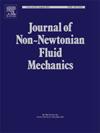不同通道润滑流压力梯度的一般评价,并应用于线性和双曲收缩
IF 2.8
2区 工程技术
Q2 MECHANICS
引用次数: 0
摘要
在经典润滑近似下,我们开发了一个统一的框架来评估不可压缩的等温粘弹性流体在具有缓慢变化几何形状(包括惯性)的对称通道中的压力梯度。利用压力梯度与壁面法向坐标的独立性(这是一般二维平面或三维轴对称流所没有的特性),我们推导了压力梯度和保持恒定流速所需的相应平均压降的多个积分表达式。推导使用了通过额外应力张量形成的动量平衡,提供了一个灵活、正式和严格的程序,并讨论了每个表达式的物理意义。为了避免在这些表达式中进行选择,我们引入了一组新的基于流函数、映射坐标和转换聚合物额外应力分量的润滑方程。该公式自动满足连续性方程、流体不可压缩性约束、边界条件和流动对称性,允许后验确定压力梯度,并为一致性和准确性检查提供工具。积分表达式的等价性在两种典型情况下得到说明:(i)线性收缩通道中的牛顿惯性流动,以及(ii)双曲收缩通道中的粘弹性无惯性流动。在这两种情况下,预测的平均压降与通过pad本文章由计算机程序翻译,如有差异,请以英文原文为准。
General evaluation of the pressure gradient for lubrication flows in varying channels with applications to linear and hyperbolic contractions
Under the classic lubrication approximation, we develop a unified framework for evaluating the pressure gradient of an incompressible, isothermal viscoelastic fluid in a symmetric channel with slowly varying geometry, including inertia. Exploiting the independence of the pressure gradient from the wall-normal coordinate—a property absent in general 2D planar or 3D axisymmetric flows—we derive multiple integral expressions for the pressure gradient and the corresponding average pressure drop required to maintain a constant flow rate. The derivations use the momentum balance formulated via the extra-stress tensor, providing a flexible, formal, and rigorous procedure, and the physical significance of each expression is discussed.
To bypass choosing among these expressions, we introduce a new set of lubrication equations based on a streamfunction, mapped coordinates, and transformed polymer extra-stress components. This formulation automatically satisfies the continuity equation, the constraints due to fluid incompressibility, the boundary conditions, and the flow symmetries, allowing the pressure gradient to be determined a posteriori and providing a tool for consistency and accuracy checks.
The equivalence of the integral expressions is illustrated in two representative cases: (i) Newtonian inertial flow in a linearly contracting channel, and (ii) viscoelastic inertialess flow in a hyperbolic contraction. In both cases, the predicted average pressure drop agrees very well with high-order asymptotic solutions post-processed via Padé approximants, high-accuracy spectral simulations, and DNS results from the literature. The framework provides a rigorous, general, and computationally robust tool for analyzing lubrication flows of viscoelastic fluids and can be easily extended to other complex fluids and broader flow conditions.
求助全文
通过发布文献求助,成功后即可免费获取论文全文。
去求助
来源期刊
CiteScore
5.00
自引率
19.40%
发文量
109
审稿时长
61 days
期刊介绍:
The Journal of Non-Newtonian Fluid Mechanics publishes research on flowing soft matter systems. Submissions in all areas of flowing complex fluids are welcomed, including polymer melts and solutions, suspensions, colloids, surfactant solutions, biological fluids, gels, liquid crystals and granular materials. Flow problems relevant to microfluidics, lab-on-a-chip, nanofluidics, biological flows, geophysical flows, industrial processes and other applications are of interest.
Subjects considered suitable for the journal include the following (not necessarily in order of importance):
Theoretical, computational and experimental studies of naturally or technologically relevant flow problems where the non-Newtonian nature of the fluid is important in determining the character of the flow. We seek in particular studies that lend mechanistic insight into flow behavior in complex fluids or highlight flow phenomena unique to complex fluids. Examples include
Instabilities, unsteady and turbulent or chaotic flow characteristics in non-Newtonian fluids,
Multiphase flows involving complex fluids,
Problems involving transport phenomena such as heat and mass transfer and mixing, to the extent that the non-Newtonian flow behavior is central to the transport phenomena,
Novel flow situations that suggest the need for further theoretical study,
Practical situations of flow that are in need of systematic theoretical and experimental research. Such issues and developments commonly arise, for example, in the polymer processing, petroleum, pharmaceutical, biomedical and consumer product industries.

 求助内容:
求助内容: 应助结果提醒方式:
应助结果提醒方式:


